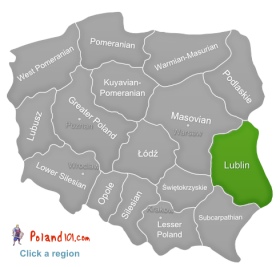Lublin - Chelm, Roztocze Landscape Park, Polesie National Park, Zamość, Janow Podlaski
0 Lublin Diaspora around the world
Our in-person family gatherings
Ireland's President Higgins family message
Our TEDx talk about family gatherings

General information
Lublin lies next to the wild Bug river, which is the natural border to Belarus and the Ukraine. In this area of Poland, the visitor can see the many different influences of various cultures and countries that were involved with Poland in the past (either peacefully or violently). The Lublin region has something to offer for lovers of history and architecture, for art lovers, for people who prefer spending time in forests, and also for people who would like to explore underground cave systems.
Traveling to and within the area
If you would like to travel into Lublin from outside the country, then you can use the Lublin airport which has good connections to other European countries. It is easy to get from the airport to the city. Once you have arrived in the region, you can make use of a good train and bus system. People who would like to hire a car or arrive with their own car should get a good road map.
Local specialties
When it comes to special things from this regions, then one needs to mention the Arab horses from the Janow Podlaski studs. No other place in Poland has bred Arabs for so long, and on such a scale. The Arabs are sold to customers all over the world. The city of Janow Podlaski is definitely the place for you if you would like to have a holiday that includes horses.
Sights, places, and activities you should not miss
While Chelm generally has the flair of an industrial city, there is a lot to see for a visitor. The most interesting feature are the underground tunnels. They were dug into the chalk underneath the town, and were used for shelter since the Middle Ages. Today, they are simply a tourist attraction. Visiting the Chelm Chalk Tunnels is definitely worth your time. The tour takes a little bit less than an hour and leads you through approximately two kilometers of tunnels in which some interesting exhibitions will tell you more about the history of the chalk tunnels. Chelm is surrounded by the Chelm Landscape park, a protected area.
Roztocze Landscape Park: This landscape park is only partially in Lublin, but worth mentioning because it is a lovely place and fits into your holiday if you like ponies. There are quite a few Polish ponies around in the Roztocze landscape park. But of course, you can also just enjoy the park for its lovely valleys, plenty of waterfalls, and hills.
The Polesie National Park is a protected wetland, forest, and also covers a few peat land areas. It is a rather flat park, and the forests are mainly Tundra forests. While the landscape might not be as dramatic as other regions in Poland, the wildlife watching in this regional park can be very rewarding as up to 150 species of birds can be sighted in that park.
Zamość is mainly worth a visit because of its historical center that has been added to the UNESCO world heritage list in the year 1992. The architecture of Zamość is mainly Renaissance, and many well preserved buildings can be seen within the historic center. The market square is popular with locals and visitors alike.
Lublin (the city): Lublin is the city from which the whole region gets its name from. Lublin was on the list of cities that were candidates for the title “2016 European Capital of Culture”. One title that belongs to Lublin without any contest is “Gate to the East” because of its location close to other countries. It is also a very popular city for visitors – it has plenty to offer for all sorts of tourists. The Lublin Museum is one of the oldest and best museums in Eastern Poland. If you have an interest in art, then you could spend a few days just exploring the various galleries in the city. There are plenty of festivals all year round, and of course the old city of Lublin also has a few interesting architectural sights for you!
Scenes of the movie “The Reader” have been filmed in the Majdanek concentration camp. This concentration and extermination camp was erected just outside the city of Lublin by the German Nazis. The difference between this concentration camp and other concentration camps in Poland is that it was built within the boundaries of a city, and not in a remote area “out of sight”.

_(2).jpg)